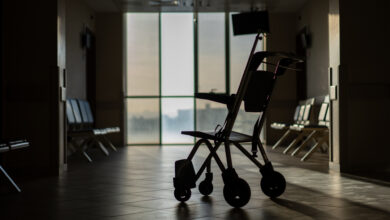East African crisis challenges health workers globally
Medical aid agencies working in East Africa face a worsening health crisis compounded by political and bureaucratic tensions. Linda Belardi speaks to Médecins Sans Frontières Australia for the latest.
Dr Clara van Gulik is Médecins Sans Frontières’ medical advisor in paediatrics and nutrition.
She has worked with the nobel prize- winning medical aid agency since 2005 in coordination and as a doctor in the field. A consultant in paediatric HIV and TB she has worked in Burundi, Ivory Coast, Central African Republic, Guinea, Malawi and in London. van Gulik was also part of the emergency coordination team responding to the 2009 meningitis epidemic in Niger.
In an interview with Nursing Review, van Gulik said that the situation in Somalia was extremely challenging because aid agencies could not go into the the country freely to assess the situation.
MSF has programs running in refugee camps in Kenya and Ethiopia and in Mogadishu, the capital of Somalia, but it was hard to tell the real severity of the situation.
However, she said even before the present crisis the situation in Somalia was already grim after 20 years of conflict: “There have been pockets that have been particularly affected in terms of food security and healthcare access, and these are the very places that we cannot even assess the situation.”
Poor rainfall and drought, which had affected cattle and the general production of food was making a bad situation even worse. van Gulik said Somalis, who were managing to get to the refugee camps in Kenya and Ethiopia, were often severely nourished.
MSF has nine medical clinics in Somalia and is increasing the number every week but many more are needed. In the clinics in Mogadishu and around the outskirts of the capital, MSF was seeing increasing cases of acute watery diarrhoea due a lack of access to clean water.
Another problem was vaccination coverage. It is so low that just a few cases of measles is concerning and MSF is actively trying to get measles vaccination campaigns in place.
The age group most affected when there is a lack of food is children under the age of five. “If there are high malnutrition rates for children under the age of five, we can extrapolate that the rest of the population is also affected. What we are seeing now is that children over the age of five are also reaching severe acute malnutrition, so it further emphasises how bad the situation is within Somalia in terms of food security.”
The specialist, who studied at Imperial College School of Medicine in London and worked in various London hospitals before joining MSF, said a lack of current population data has also added to the difficulty of assessing the needs of the population.
“We have such a poor insight into Somalia that we don’t even really know what the current population data is – existing numbers are based on historical population data. There has been no proper government in place in decades, which adds to the difficulty of understanding their needs and obtaining accurate data.”
To obtain an accurate picture, MSF conducts its own clinical assessments, she said.
“We want to make sure that the assessment we have clearly reflects what the people’s needs are in terms of medical care and their health needs and then we respond to that. It also allows us to set priorities.
“What we can say is that the number of people who are leaving Somalia to get to the camps is already very large. But they represent only the few who are actually making it as far the camps. We can only imagine that it must be so much worse for the people who are still back in Somalia”
van Gulik was hopeful though that now that the agency had started operations in Mogadishu it would slowly get a clearer idea of the huge medical needs, as well as the nutritional needs of the population. “So far we have managed to assess about 1,000 children for their nutritional status and have found up to 50 per cent of children with severe malnutrition.”
She said 100 per cent of child deaths were from acute watery diarrhoea so MSF was concerned that cholera would become a significant health problem.
“In other areas we are finding that about half the children who are under the age of five are malnourished. The medical needs are huge but again, variable. Measles as well will aggravate the situation even more”.
The numbers are indeed confronting. Between 1000 and 3000 people are crossing daily into the camps in Ethiopia and Kenya. In Mogadishu there are about 100, 000 displaced people who are settled in various camps who need help. The MSF programs to treat severe acute malnutrition have 34, 608 children enrolled between Somalia and the camps in Ethiopia and Kenya - and that’s just the children.
In the Dagahaley camp in Kenya, van Gulik said MSF was providing medical care for 130, 000 people, of which 6,400 are children being treated for severe malnutrition. There is another camp called IFO in Kenya. There are 25,000 refugees based mainly on the outskirts of the camp. The camp itself has an even higher number of people. In Ethiopia MSF is providing medical care to 20,000 refugees that are gathered there and about 10, 000 children are being treated there for severe acute malnutrition.
Because of the political complexities of negotiating with the various armed groups in the region, MSF only works with its own supplies. She said MSF was managing to stock its clincs partly because it already had several projects which have been long-running in Somalia. “Often hospitals and clinics that we have been running for many years have a storage of supplies and it is just a matter of moving these resources to where they are needed most.”
In recent weeks four charter planes carrying 55 tonnes of equipment, medicine and therapeutic food have been flown to Mogadishu and because there is also a port in the capital there was a possibility of getting supplies in by boat.
When asked if she thought the crisis could be contained, the doctor, said she did not think it would be easily contained because the underlying issues were so complex
“Basically, if the 20 year conflict in Somalia doesn’t get resolved it would be hard to see how the situation could really improve drastically for the Somali people who are the victims stuck in the middle of this.”
The drought and death of cattle has led to food prices being hiked up between 200 and 400 per cent for basic products like rice and wheat. The hike is also part of the global economic situation and again that is not something that can be easily resolved.
“Definitely the solution here is not just about providing food or providing money to buy food. We can try to reduce the number of deaths that are caused by epidemic diseases caused by overcrowding in displaced camps such as measles, cholera and watery diarrhoea.
“Our main objective is to reduce the mortalities and morbidity but the greater picture is so complex that it will be difficult to affect those other factors.”
However, all of the complexities are not historic or even long term problems, the slowness of the bureaucracy is an immediate problem. The way it works in the camps is that once refugees arrive they have to be registered first before they can officially have access to food, housing and medical care. “When this process is slowed down due to bureaucratic and political reasons this is something where we can say this crisis can be dealt with better,” said van Gulik.
“ We are trying to provide medical care for the growing number of refugees, but in terms of all the other factors in place we need all of the other international actors, plus the hosting government to respond to that adequately. “
The reality of this situation is that once the basics are there - appropriate water and sanitation measures, high coverage of measles vaccination, adequate shelter, people getting food, medical care - then there would be a noticeable reduction in the mortality rate.
“ If this was happening anywhere in any other part of the world, we could send in huge amounts of resources, lots of international staff to support the local staff and work with the government to really launch a big response. But this is what we are struggling to do here in Somalia.”
Email: [email protected]





